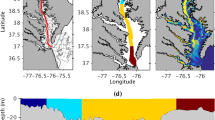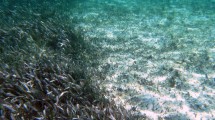Abstract
We examined the impacts of macrophyte beds dominated by a canopy-forming (Myriophyllum sibiricum) and a meadow-forming (Chara canescens) species on bottom shear stress (τ) and resuspension in shallow Lake Christina, Minnesota (U.S.A.). Studies were conducted in late summer, 1998, when macrophyte biomass levels exceeded 200 g m−2, and in early summer, 2000, when biomass was greatly reduced (<20 g m−2) in both plant beds. The critical shear stress (τc) of sediments, measured experimentally in the laboratory, was low (1.4 dynes cm−2) indicating potential for resuspension in the absence of macrophytes. During 1998, turbidity was low at the M. sibiricum and Chara station, rarely increasing when calculated bottom τ (calculated from wave theory assuming no biomass obstruction) exceeded τsub c sub, indicating that both beds reduced sediment resuspension at high biomass levels. In situτ (estimated τ), measured via gypsum sphere dissolution, did not exceed τc above the sediment interface in either bed during 1998. In contrast, sediment resuspension occurred in both beds during similar high winds in 2000. However, estimated τ was lower than calculated bottom τ, suggesting that at low biomass, macrophytes were having some impact on τ.
Similar content being viewed by others
References
APHA (American Public Health Association), 1992. Standard Methods for the Examination ofWater andWastewater, 18th edn. American Public Health Association, Washington, D.C.
Bailey, M. C. & D. P. Hamilton, 1997. Wind induced sediment resuspension: a lakewide model. Ecological Modeling 99: 217–228.
Barko, J. W. & W. F. James, 1998. Effects of submerged aquatic macrophytes on nutrient dynamics, sedimentation, and resuspension. In Jeppesen, E., M. Søndergaard, M. Søndergaard, K. Christoffersen (eds), The Structuring Role of Submerged Macrophytes in Lakes. Springer-Verlag, New York, NY. 423 pp.
Bengtsson, L. & T. Hellström, 1992. Wind-induced resuspension in a shallow lake. Hydrobiologia 241: 163–172.
Breukers, C. P. M., E. M. Van Dam & S. A. De Jong, 1997. Lake Volkerak-Zoom: a lake shifting from the clear to the turbid state. Hydrobiologia 342/343: 367–376.
Carper, G. L. & R. W. Bachmann, 1986. Wind resuspension of sediments in a prairie lake. Canadian Journal of Fisheries and Aquatic Sciences 41: 1763–1767.
Coastal Engineering Research Center, 1984. Shore protection manual, Volume 1. U.S. Army Corps of Engineers, Waterways Experiment Station, Vicksburg, Mississippi, USA.
Deiter, C. D., 1990. The importance of emergent vegetation in reducing sediment resuspension in wetlands. Journal of Freshwater Ecology 5: 467–473.
Eckman, J. E., D. O. Duggins & A. T. Sewell, 1989. Ecology of understory kelp beds. I. Effects of kelps of flow and particle transport near the bottom. Journal of Experimental Marine Biology and Ecology 129:173–187.
Filbin, G. J. & J. W. Barko, 1985. Growth and nutrition of submersed macrophytes in a eutrophic Wisconsin impoundment. Journal of Freshwater Ecology 2: 275–286.
Fonseca, M. S. & J. S. Fisher, 1986. A comparison of canopy friction and sediment movement between four species of seagrass with special reference to their ecology and restoration. Marine Ecology Progress Series 29: 15–22.
Fonseca, M. S. & J. A. Cahalan, 1992. Preliminary evaluation of wave attenuation by four species of seagrasses. Estuarine and Coastal Shelf Sciences 35: 565–576.
Fonseca, M. S., J. S. Fisher, J. C. Zieman & G. W. Thayer, 1982. Influence of the sea grass, Zostera marina L., on current flow. Estuarine and Coastal Shelf Science 15: 351–364.
Gambi, M. C., A. R. M. Nowell & P. A. Jumars, 1990. Flume observations on flow dynamics in Zostera marina (eelgrass) beds. Marine Ecology Progress Series 61: 159–169.
Gregg, W. W. & F. L. Rose, 1982. The effects of aquatic macrophytes on the stream micro-environment. Aquatic Botany 14: 309–324.
Håkanson, L., 1977. The influence of wind, fetch, and water depth on the distribution of sediment in Lake Vanern, Sweden. Canadian Journal of Earth Sciences 14: 397–412.
Hamilton, D. P. & S. F. Mitchell, 1996. An empirical model for sediment resuspension in shallow lakes. Hydrobiologia 317: 209–220.
Hanson, M. A. & M. G. Butler, 1990. Early responses of plankton and turbidity to biomanipulation in a shallow prairie lake. Hydrobiologia 200/201: 317–327.
Hanson, M. A. & M. G. Butler, 1994. Response of plankton, turbidity, and macrophytes to biomanipulation in a shallow prairie lake. Canadian Journal of Fisheries and Aquatic Sciences 51: 1180–1188.
Hosper, H., 1989. Biomanipulation, a new perspective for restoring shallow, eutrophic lakes in the Netherlands. Hydrobiological Bulletin 23: 11–19.
Hosper, H. & E. Jagtman, 1990. Biomanipulation additional to nutrient control for restoration of shallow lakes in the Netherlands. Hydrobiologia 200/201: 523–534.
James, W. F. & J. W. Barko, 1990. Macrophyte influences on the zonation of sediment accretion and composition in a northtemperate reservoir. Archiv für Hydrobiologie 120: 129–142.
James, W. F. & J. W. Barko, 1994. Macrophyte influences on sediment resuspension and export in a shallow impoundment. Lake and Reservoir Management 10: 95–102.
James,W. F., E. P. Best & J.W. Barko, 2003. Sediment resuspension and light attenuation in Peoria Lake: Can macrophytes improve water quality in this shallow system? Hydrobiologia (in press).
Jeppesen, E., M. Søndergaard, M. Søndergaard & K. Christoffersen, 1998. The Structuring Role of SubmergedMacrophytes in Lakes. Ecological Studies 131. Springer-Verlag, New York, 423 pp.
Koch, E. W., 1996. Hydrodynamics of a shallow Thalassia testudinum bed in Florida, USA. In Kuo, J., R. C. Phillips, D. I. Walker & H. Kirkman (eds), Seagrass Biology: Proceedings of an International Workshop, Rottnest Island, Western Australia, 25-29 January 1996: 105-109.
Koch, E. W. & G. Gust, 1999. Water flow in tide and wave dominated beds of the seagrasses Thalassia testudinum. Marine Ecology Progress Series 184:63–72.
Lick, W., Y-J Xu & J. McNeil, 1995. Resuspension properties of sediment from the Fox, Saginaw, and Buffalo Rivers. Journal of Great Lakes Research 21: 257–274.
Lopez, F. & M. Garcia, 1998. Open-channel flow through simulated vegetation: Suspended sediment transport modeling. Water Resources Research 34: 2341–2352.
Maceina, M. J. & D. M. Soballe, 1990. Wind-related limnological variation in Lake Okeechobee, FL. Lake and Reservoir Management 6: 93–100.
Petticrew, E. L. & J. Kalff, 1991. Calibration of a gypsum source for freshwater flow measurements. Canadian Journal of Fisheries and Aquatic Sciences 48: 1244–1249.
Porter, E. T., L. P Sanford & S. E. Suttles, 2000. Gypsum dissolution is not a universal integrator of 'water motion'. Limnology and Oceanography 45: 145–158.
Scheffer, M., 1990. Multiplicity of stable states in freshwater systems. Hydrobiologia 200/201: 475–486.
Scheffer, M., H. S. Hosper, M. L. Meijer, B. Moss & E. Jeppesen, 1993. Alternative equilibria in shallow lakes. Trends in Ecology and Evolution 8: 275–279.
Smart, R. M. & G. O. Dick, 1999. Propagation and establishment of aquatic plants: A handbook for ecosystem restoration projects. Technical Report A-99-4, U.S. Army Engineer Waterways Experiment Station, Vicksburg, MS.
Timms, R. M. & B. Moss, 1984. Prevention of growth of potentially dense phytoplankton populations by zooplankton grazing in the presence of zooplanktivorous fish in a shallow wetland ecosystem. Limnology and Oceanography 29: 472–486.
Tsai, C. H. & W. Lick, 1986. A portable device for measuring sediment resuspension. Journal of Great Lakes Research 12:314–321.
Van Den Berg, M. S., H. Coops, M. L. Meijer, M. Scheffer & J. Simons, 1998. Clear water associated with dense Chara vegetation in the shallow and turbid Lake Veluwemeer, The Netherlands. In Jeppesen, E., M. Søndergaard, M. Søndergaard & K. Christoffersen (eds), The Structuring Role of Submerged Macrophytes in Lakes. Springer-Verlag, New York, NY. 423 pp.
Author information
Authors and Affiliations
Rights and permissions
About this article
Cite this article
James, W.F., Barko, J.W. & Butler, M.G. Shear stress and sediment resuspension in relation to submersed macrophyte biomass. Hydrobiologia 515, 181–191 (2004). https://doi.org/10.1023/B:HYDR.0000027329.67391.c6
Issue Date:
DOI: https://doi.org/10.1023/B:HYDR.0000027329.67391.c6




